|
|
|
26 January 09: Winter of the Delaware, or,
fly, eagles, fly
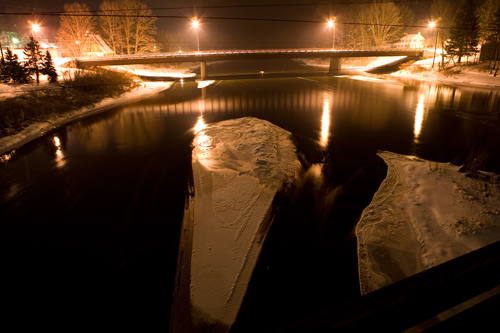
I woke on Saturday morning on my own will; the wake-up call I'd asked for never came. Then again the concierge could only tell me about the vending machine
on
the second floor when I asked him if there was anywhere to get something to eat at midnight in this town . . . and with a pack of vanilla wafer cookies --
the
ice cream cone sticks with the icing on the inside -- I sat down on the balcony to see a Chinese restaurant across the street with a red neon "OPEN" sign and
a
phone number on the banner. I called over and within fifteen minutes had washed down my wafers with a dessert of shrimp lo mein and a shake of my head at the
goofball concierge.
Wild Turkey is a sneak, boy . . . that 101 will turn things weird in a second, and the next thing you know you're out back having a tap in the parking
lot with an old doobie brother who resembles Skunk Baxter and an American Indian cook who boasts that she'll scalp him from his head to his ass if he
doesn't hurry up and pass that shit to the left. The minute after that you're walking across an active train bridge to get a closer look at the Delaware
River
below.
More accurately, the East Branch of the Delaware River, which runs through the Main Street and Front Street parts of Hancock, New York, the town of 1,100
where the East Branch and West Branch converge into one Delaware River. I get the impression that Hancock has a decent enough tourism draw -- fly fishing in
the area is the best in the country, and there's something to be said about being a two and a half hour, scenic Catskills drive from NYC -- but it's slow
going
in the winter. I swear I was the only guest at the Hancock House Hotel, but Honest Eddie's bar was bumpin'.
After a breakfast of advil and hotel lobby coffee, I was on the road -- Popkin's train would arrive in Port Jervis at noon, so I thought, and I had a few
hours
to get those 70 miles. A landmark among the Bridges of the Delaware was right on the way.
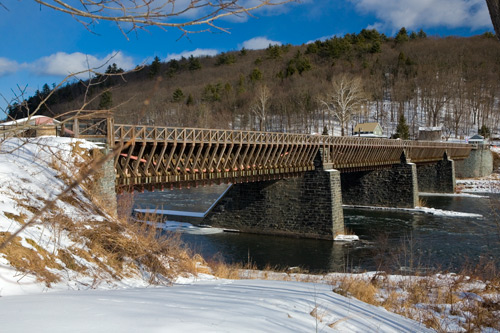
With the temperature barely in two digits and drifts of snow blown across the otherwise well plowed and salted NY-97, the drive on the scenic byway
was
the white winter hymnal those weird beards from Seattle sang about. There are thirteen
bridges
across the Delaware between the Hancock headwaters and the southern tip of Jervis, where New York, New Jersey and Pennsylvania form a point marked by a
subtle
granite block from some time around the Civil War. Nearly all of the bridges were built in response to several years of previous bridges who lost battles to
floods. They're small, often one-lane, and carry rural state roads in New York to rural state roads in PA, connecting towns like Lordville with Equinunk,
Narrowsburg with Darbytown.
At Minisink Ford, another one lane bridge crosses the Delaware into Lackawaxen, PA. This one happens to be the oldest cable suspension bridge in the country,
designed by the engineer whose masterpiece Brooklyn Bridge opened 36 years after this one opened -- as an aqueduct. John Roebling, whose son Charles founded
the town with the family's name just upstream from Philly in Burlington County, New Jersey, engineered the Delaware Aqueduct as one of four for the Delaware
and Hudson Canal Company, which transported anthracite coal from northeastern PA to New York City.
If the need for a bridge of water across a river of water seems strange, it made sense then: the river was already well in use by lumber companies upstream
who
sent their product downstream to market in Easton and Philadelphia via timber rafts -- enormous rafts assembled from the logs, manned by river sailors.
These rafts had no breaks, so needless to say, any slow moving coal barges being transported perpendicularly across a river presented a hazard -- or an easy
target -- for the much larger and much faster timber rafts.
Roebling's 535', four span aqueduct opened in 1847, freeing the barges from the charging rafts while issuing the charging rafts a permanent obstacle.
Incidentally, both industries were pretty dried up by the end of the century, thanks to the depletion of their respective natural resources and the steady
growth of the railroad. The aqueduct was converted to a bridge for pedestrians and horse drawn wagons in 1908, and shortly thereafter it was fitted to
accommodate auto traffic, too. After 131 years of private ownership, the bridge came into the jurisdiction of the National Park Service, which established
the
Upper Delaware Scenic and Recreational River in 1978. The NPS most recently reconstructed the towpaths (now pedestrian walkways), walls and the pointed
icebreakers in the river 1995, but the wire cabling is Roebling's original from 1847.
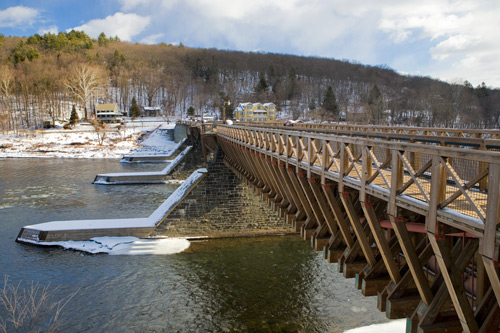
On the New York side of the bridge, the NPS has turned the one-time tollhouse into a mini-museum about the bridge. Zane Grey, the turn-of-the-20th-century
Penn
baseball standout turned Old West novelist, owned a home on the PA side where his literary career took off, thanks largely to his wife-manager Dolly, a local
girl from Lackawaxen. That house is now a museum, and the front yard leading down to the Delaware is popular with birders. Conveniently for them, and
surprisingly to me, the Eagle Institute, a non-profit which compiles data and resources to help protect and preserve eagles and educate the people that flock
to see them, has a winter field office in the only building between Grey's house and the bridge.
Having never seen a bald eagle in the wild, I was intrigued by the full parking lot and the sign saying "come in". After walking across the cold, windy and
empty bridge, I did come in, and in doing so I interrupted a lecture by a ranger who was about to lead the group of 15-20 into a van and onto somewhere,
presumably, with eagles. I tend to shy away from van rides with strangers I've already irritated, so I headed back out across Roebling's bridge in hopes that
I'd maybe spot an eagle on the way to meet Popkin in Port Jervis.
About halfway onto the bridge, there was a middle aged man and his daughter my age, so in the supposed local parlance I asked, "seen any eagles?" The father
pointed to the sky, way up to the sky, and said "that's one right there." Having never seen one, I was incredulous that the tiny bird in the distance was an
eagle. That's when it started to swoop, the little dot in the sky growing as it glided down the Delaware valley. The father was yelling to his daughter's
fiancé on the bank to come quick; he was yelling to me to get my camera ready. The daughter was speechless.
Here it was, this American bald eagle, flying right toward us, right over the oldest suspension bridge in the country, its white head picking up the glint of
the clear winter sun as it came into view. Whoosh. It passed by, not 60' above our heads on its way back up. He wasn't fishing; he was showing off.
I didn't take a single picture; I watched the show. The father was beside himself, saying he'd never seen anything like it and wouldn't be surprised if we
all
went the rest of our lives and never saw it again. The daughter was wiping her eye, clearly moved by this big bird.
That's when it played the part of a star spangled movie star, gliding into an All-American mid-air U-turn, as graceful as you'd expect an eagle to be written
about. As it started the return descent, it started flying hard, its seven foot wingspan making a soft thwap-thwap as it flew back above us on its way to a
treetop perch. On this second chance, I did use the camera already in my hands.
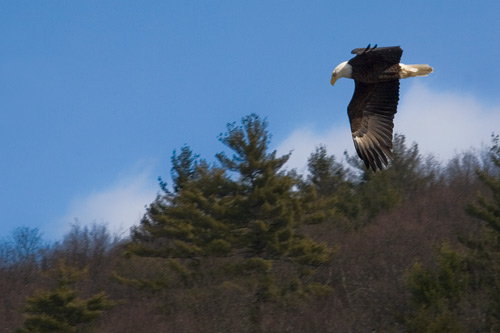
* * *
Seeing bald eagles in zoos has always depressed me. Seeing them in TV commercials or "Never Forget" commemorative plates has never inspired me. Seeing my
first
bald eagle in the wild, on top of a historic bridge where I'd stopped at without any intention of seeing eagles . . . well, that was better than
the zoos and the plates. And it's a little irksome that, after returning to Philadelphia, I learned there is now a pair of bald eagles nesting in Pennypack
Park, in addition to the pairs in recent years at Petty's Island, the Navy Yard and Tinicum, none of which I'd ever seen . . . but no matter, seeing that
eagle as I did, over my river, was remarkable.
It was the six eagles I saw later that blew me away.
Popkin was a little salty that I was a half hour later than his train was in frigid Port Jervis, since after all I was the one who suggested he take the
train from NYC (where he'd been the night before) . . . but as soon as we dropped the car on his beloved Old Mine Road and soaked our boots in the six inches of snow on the unplowed ancient
highway, all was well. All was better still when we got far enough away from roads that all we heard was the sound of the rushing river . . . and an
unfamiliar
squawk.
I stopped and looked up through the trees to see another bald eagle flying overhead. Right then, we slid down the fifteen foot bank to the frozen sandy shore
of the river, above which six of these large birds were playing and flirting, partying like it's 1699. There was one particularly frisky pair that would dive
together and kiss, one of them tumbling each time like some well-practiced air show 360. Neither of the humans said anything.
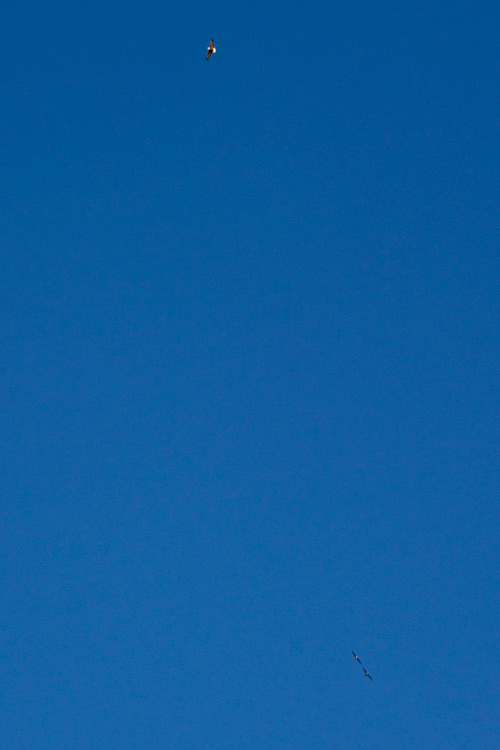
* * *
A couple miles into the wilderness and 130 miles upstream on the river that passes within seven blocks of both of our houses, time slips fast when you're
watching eagles fly. Noting just how golden the glow was on these aerial American idols, I flashed back two weeks and about fifteen miles south, when I was
stuck in the snowy woods after dark. Nathaniel commented on the gradient hues the setting sun cast through the woods, from the bright orange paintbrush
treetops to the blue's blue of the river, and all the gray in between. "I know this gray," I told him. "Let's get out of the woods."
That we did, and with a little twilight to spare. And we saved all the McNabb/Reid eagle jokes for the rack of ribs (his), the surf & turf (mine) and a cold
Warsteiner at the Walpack Inn.
* * *
NOTES & SOURCES:
• Eagle Institute.
• NPS: Upper Delaware River Scenic and Recreational River.
• NPS: Delaware Water Gap National Recreation Area.
• UpperDelaware.com, a guide to the region.
• Bridges over the Delaware River, Frank
Dale, Rutgers University Press, 2003.
• "A third eagles nest in
Philadelphia," Sandy Bauers, Inquirer, 10 Jan 2009.
–B Love
|
SUMMER OF THE DELAWARE ARCHIVES:
|
|